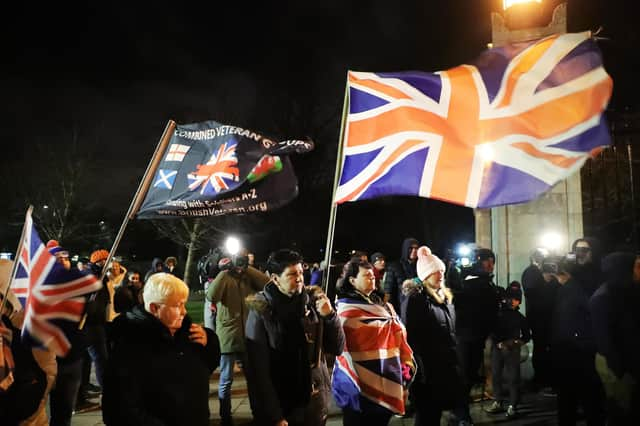Ben Lowry: After all the political twists and turns, a full Irish Sea border is finally here


In theory, and indeed in reality, there has been a border for almost three years, but the extent of it has been disguised.
It is worth recapping on how we got here, so eventful has the journey been and so easy therefore to forget its contours.
Advertisement
Hide AdAdvertisement
Hide AdThe Brexit referendum was in June 2016 when the UK narrowly voted to leave the EU, and the legal device known as Article 50 to bring about that departure was triggered by Theresa May in March 2017, which gave Britain two years to depart. Emboldened by this action, the then prime minister called a snap general election which she lost, only staying in Downing Street with DUP support.
Despite this arrangement, later that year she agreed a backstop with the EU, a form of border in the Irish Sea, but the Tory Party was unable to agree on an exit plan – to a significant extent because of disagreements over how to handle Brexit in NI – and it had to ask the EU for three extensions to avoid being ejected without an exit deal at the expiry of the two-year period under Art 50.
Towards the end of that period Boris Johnson took over as prime minister, having travelled to Belfast in late 2018 to undermine Mrs May and tell the DUP that he would never accept a regulatory or customs Great Britain-NI border. Within weeks of becoming PM he agreed the first of those with the DUP, a concession that the party says it only agreed on the basis of a Stormont lock and there being no tariff border, but which nonetheless emboldened Mr Johnson to give the EU more on NI when it rejected that initial deal.
The United Kingdom finally left the European Union on January 31 2020. When unionists celebrated at the gates of Stormont I wrote an article saying they were celebrating what was possibly a small step towards a united Ireland – certainly the biggest such move since 1921, bigger even than the disastrous 1985 Anglo Irish Agreement. Some of them did not like my observation but I stand by it.
Advertisement
Hide AdAdvertisement
Hide AdThe UK did not in effect leave the EU until a year later, the start of January 2021, because Britain was given 11 months to prepare before the departure became operational. Thank goodness too – the coronavirus struck causing major political distractions, and so the prospects of a no-deal exit arose again, this time in the form of no-trade deal departure.
Boris Johnson produced one of his dramatic last minute flourishes and signed a trade agreement in December 2020, just before the full UK departure came into force. And on January 1, the Northern Ireland Protocol, which established the Irish Sea border for goods, came into force. But it too was introduced in phases because of its complexity and far-reaching impact. Even so, however, opposition to the barrier suddenly emerged because people across Northern Ireland began to be unable to order favoured goods from GB or make certain movements unhindered.
The DUP, whose leading members in the preceding months had played down the constitutional impact of the trade border and even welcomed its dual access to the rest of the UK and the EU, markedly toughened their position. Mr Johnson, who with his NI Secretary Brandon Lewis, had denied there even was a border, did too.
Later in January, the EU proposed invoking a device called Article 16 which would suspend the protocol in a row over vaccines, but never did so. However, this gave fuel to UK anger over the trade barrier and when by March it was clear that even a partially implemented protocol was not working the UK unilaterally took steps to extend grace periods relating to parts of the border that had not yet come in. The EU responded with legal action.
Advertisement
Hide AdAdvertisement
Hide AdThen Mr Johnson’s government began to work on political plans such as the NI Protocol Bill which would have overhauled the protocol radically, and leading unionists took legal action against the Irish Sea border (that they lost). Grace periods were further extended.
Last summer, 2022, Rishi Sunak became prime minister and maintained strong opposition to the Irish Sea border, but less strong than his predecessor Liz Truss had done. In January he signed the Windsor Framework, which alleviated the worst impact of the protocol. But the protocol had never been implemented in full. Thus Irish Sea restrictions tomorrow will be the tightest they have ever been. And even the framework will be implemented in phases so the border will get harder still over time. How much harder? We will report on that.
For now read Chris Heaton-Harris and Sir Jeffrey Donaldson on pages 14 and 15. Mr Heaton-Harris paints a picture of warm London-DUP relations, Sir Jeffrey less so.
You will draw your own conclusions. My initial sense is that Sir Jeffrey in his robust article is playing down any idea of an internal split in the DUP, while keeping open a return to Stormont without the framework being scrapped.